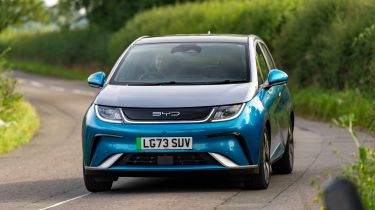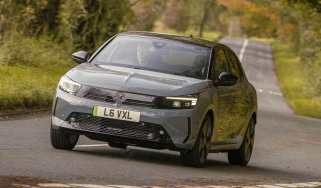BYD Dolphin - Electric motor, performance & drive
It’s not much fun to drive, but the BYD Dolphin is comfortable enough for daily use

There are three powertrain combinations in the BYD Dolphin. You can choose the entry-level model with a 94bhp motor and a 44.9kWh battery, or a 174bhp car in ‘Boost’ trim with the same battery size. The two higher-spec models in the range use a 201bhp motor alongside a 60kWh battery, giving greater range and faster acceleration.
Base versions are quite slow as electric cars go, taking 12.3 seconds to go from 0-62mph, which is longer than the cheaper Citroen e-C3 and entry-level Vauxhall Corsa Electric. The more powerful Boost trim does the same sprint in a swifter 7.5 seconds, while the 201bhp Comfort and Design trims cut this down to 7.0 seconds. You can easily provoke wheelspin in the latter 201bhp version if you press the pedal too hard at a standing start.
That doesn’t necessarily mean it’s all that much fun; it’s just a useful amount of additional power to help get up to speed faster when needed. As with most electric cars, the motor is very quiet – there’s a typical whine, but it’s all in the background and isn’t so intrusive that it stops the Dolphin from being relaxing to drive.
Since it’s an electric car, there aren’t any gearbox options; it’s all done using a single-speed gearbox, so driving in traffic is very easy.
|
Model |
Power |
0-62mph |
Top speed |
|
Dolphin Active |
94bhp |
12.3s |
93mph |
|
Dolphin Boost |
174bhp |
7.5s |
99mph |
|
Dolphin Design |
201bhp |
7.0s |
99mph |
What is the BYD Dolphin like to drive?
In town
The soft suspension means the BYD Dolphin is comfortable when driving over speed bumps and potholes in the road. It stays nice and smooth in traffic, and the cabin is well-insulated, so it’s hushed inside at low speeds.
On A- and B-roads
The car’s squidgy suspension and high weight mean its composure falls apart on twisty country roads. There’s very little fun to be had because the controls don’t feel enjoyable to use, and you need to be careful around corners due to a lot of body lean.
More reviews
We also found the electronic stability control to be over-zealous and intrusive if you ask for swift acceleration in certain situations. It can deliver the power of even the most potent version in a straight line, but around corners, it doesn’t feel like it has the traction of more sophisticated-feeling rivals.
On the motorway
At motorway speeds, the BYD suffers from road and wind noise. In our long-term test car, we found that the wind noise was especially bad, requiring us to turn up the music to drown it out. The ride feels comfortable on the motorway, though, and the soft suspension means rough sections of road aren’t an issue.
Engines, 0-60 acceleration and top speed
The entry-level BYD Dolphin has a 94bhp motor and a 45kWh battery, but there’s also a 174bhp car with the same battery. Top-spec cars have a 201bhp motor and a 60kWh battery. All Dolphin models come with front-wheel drive.
The base 94bhp version is relatively slow compared with most EVs, taking 12.3 seconds to go from 0-62mph, but all the other versions are more than fast enough for a family car. The 174bhp Boost can do the same 0-62mph dash in 7.5 seconds, while the 201bhp Comfort and Design trims trim this down to 7.0 seconds. You can easily provoke wheelspin in the latter if you press the pedal too hard at a standing start.







